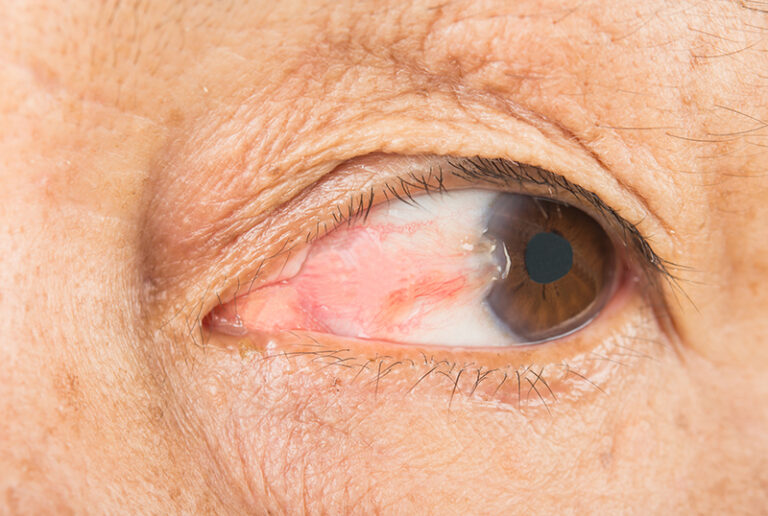
What is Pterygium?
Pterygium, or “Surfer’s Eye” is an eye condition that occurs when a red fleshy growth appears on the conjunctiva, the clear coating located on the surface of the eye. This growth may begin yellow and raised, due to its make-up of fat, proteins, and calcium deposits. As it progresses, it will become a red fleshy tissue with blood vessels. This growth typically starts developing in the inner corner of the eye and spreads towards the pupil. It may remain small or grow large enough to cover part of the cornea. When this happens, vision may be affected and/or reduced.
What are the symptoms of Pterygium?
Symptoms of Pterygium include:
- Redness and swelling of the conjunctiva
- Dryness and itching of the eye
- Irritation and burning
- Excessive tearing
- Sensation of something in the eye
- Yellow bump/spot on the white area of the eye
Vision changes/reduced vision (mostly as the pterygium progresses and grows)
If symptoms begin to affect how the eye blinks, the curvature of the cornea, or the growth becomes thick and more painful, it is important to seek medical attention. You may need to have the growth removed by a doctor.
What are the causes of Pterygium?
Pterygium is most commonly caused by ultraviolet light damage over a number of years. It can also be perpetuated or amplified by hot and dry weather along with wind and dust. Other possible causes include choline deficiencies, inflammatory disorders, and immune system or tear film abnormalities. Vascular disorders may also lead to pterygium due to uncontrolled growths of blood vessels.
How do I know if I have it or am at risk? What are the treatment options?
You will know you have Pterygium because of the appearance of an abnormal growth on the surface of the eye, typically towards the inner corner and spreading out. Though at first it may be small, you might still feel the sensation of something in your eye along with other symptoms. There are also risk factors that will make you more prone to getting pterygium. This includes:
- Those who work outdoors or live an outdoors lifestyle (Your chance may increase 150%)
- Long term exposure to the sun and UV light
- Exposure to dry, windy, or dusty weather conditions
- Those who live near the equator or in sunny climates
In most cases, a pterygium is a harmless growth. It is recommended to use artificial tears or lubricating eye drops and anti-inflammatory medicines to reduce eye inflammation. If the area becomes more inflamed and red, your doctor may prescribe steroid eye drops.
Although pterygium growths are benign, they are often mistaken for pre-cancerous eye tumors due to their similar appearance. It is important that if the lesion does not improve over time or begins to grow larger, you see a doctor for a formal diagnosis, and if removed, a biopsy may be done. Diagnosis may be completed through a full examination of the eye including inspecting the ocular surface, conjunctiva, pupils, etc. along with measurements of the cornea curvature and intraocular pressure. Then to examine the growth, a slit-lamp examination is done, in which a doctor examines the lesion under magnification.
If surgical removal is needed, modern surgical technology is used to remove the lesion from the surface of the eye. Once removed the ophthalmologist will typically transplant or move over some healthy conjunctiva tissue from other parts of the eye to the affected area. This technique reduces the chance that the lesion will grow back. This procedure is usually low risk and takes about 30 minutes to an hour to be completed. After the surgery, patients will be given instructions on aftercare which may include antibiotics or steroid drops and a patch to minimize residual bleeding and protect against infections. Recovery times may differ, but it will be at least a month for the eyes to heal.
It is important to note that pterygium is often preventable and can be avoided with the right precautionary steps. You can prevent pterygium from occurring, or reoccurring, by wearing proper eyewear or wide brim hats while in the sun, especially for prolonged periods of time. If you are in dry, windy, or dusty conditions, you may prevent pterygium by using artificial tears and lubricating eye drops to moisturize the eye and reduce the effects of wind and dust particles.



